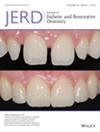Importance of an Evaluation Phase When Increasing the Occlusal Vertical Dimension: A Systematic Review
Abstract
Objective
To assess whether an evaluation period is necessary for patient and clinical success when increasing the occlusal vertical dimension (OVD) for a full mouth rehabilitation.
Materials and Methods
A systematic search was conducted in six databases: MEDLINE, Web of Science, Scopus, CENTRAL, VHL, and EMBASE. The eligibility criteria of this systematic review used the PICO framework to address the following research question: “In dentate adults requiring an increase in occlusal vertical dimension (OVD) (P), is an evaluation period of the new OVD (I) superior to no evaluation period (C) in terms of success (O)?” Study characteristics, survival, and success rates were extracted from each article. No language restrictions were applied. Study quality was appraised using Cochrane's Risk of Bias 2 tool and Newcastle–Ottawa Scale (NOS) according to the study design.
Results
The electronic search yielded 1188 titles after duplicates were removed. One RCT and 103 non-comparative articles were found relevant to the search question. Out of the 103 articles, 80 had an evaluation phase and 23 did not. The included RCT revealed that removable devices tended to cause chewing difficulties, unclear speech, and esthetic discomfort. Therefore, the use of a removable appliance to functionally or esthetically evaluate OVD was not indicated prior to the definitive treatment. Esthetics was the highest reported parameter preoperatively for the non-comparative studies, at 85% with an evaluation and 86% without.
Conclusion
At present, there is lack of evidence that an evaluation period improves clinical and patient-reported outcomes when increasing OVD for full mouth rehabilitations. Thus, an increase in OVD can be successful with or without an evaluation phase.
Clinical Significance
The evaluation phase helps the clinician manage patient expectations and assist with the treatment sequencing. This phase is most effective with fixed restoration, such as temporary crowns or adhesive restorations. However, there is limited evidence that this phase improves clinical or patient-reported outcomes.


 求助内容:
求助内容: 应助结果提醒方式:
应助结果提醒方式:


